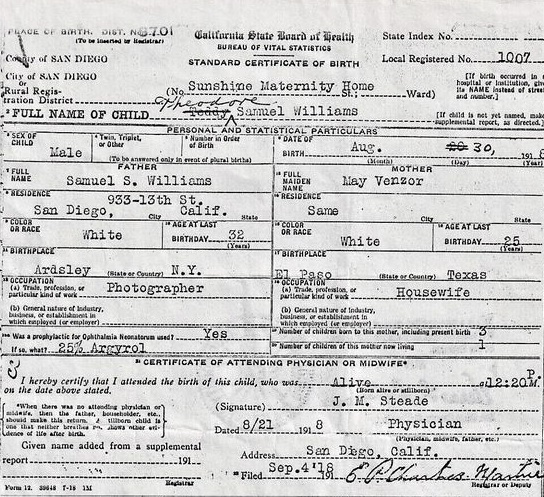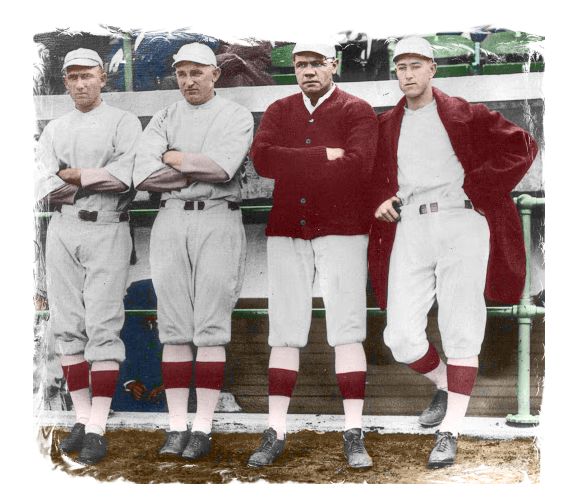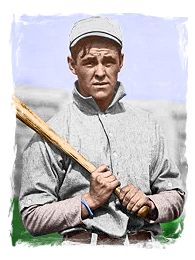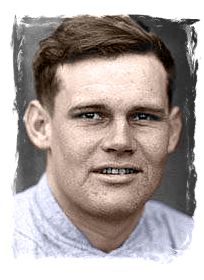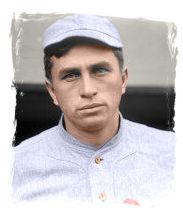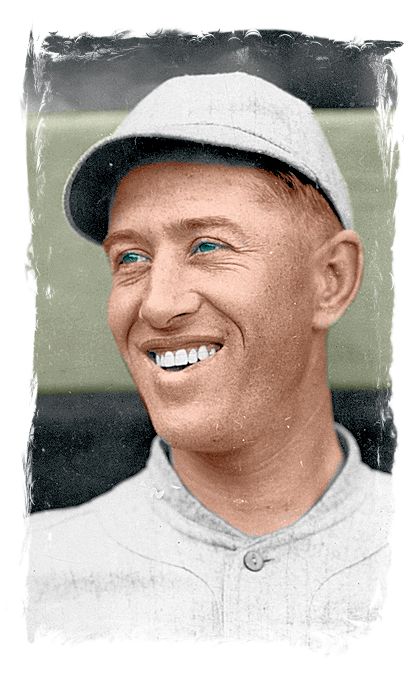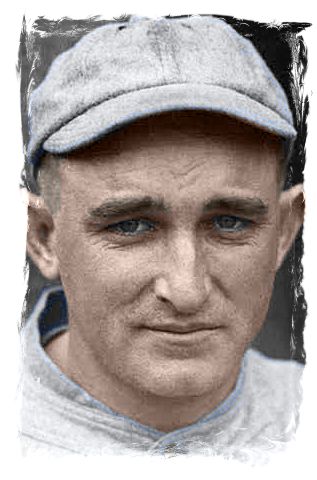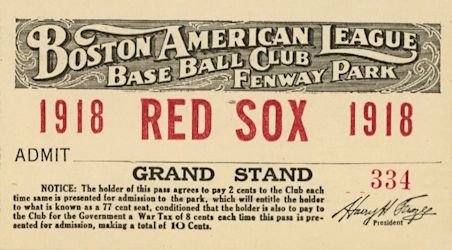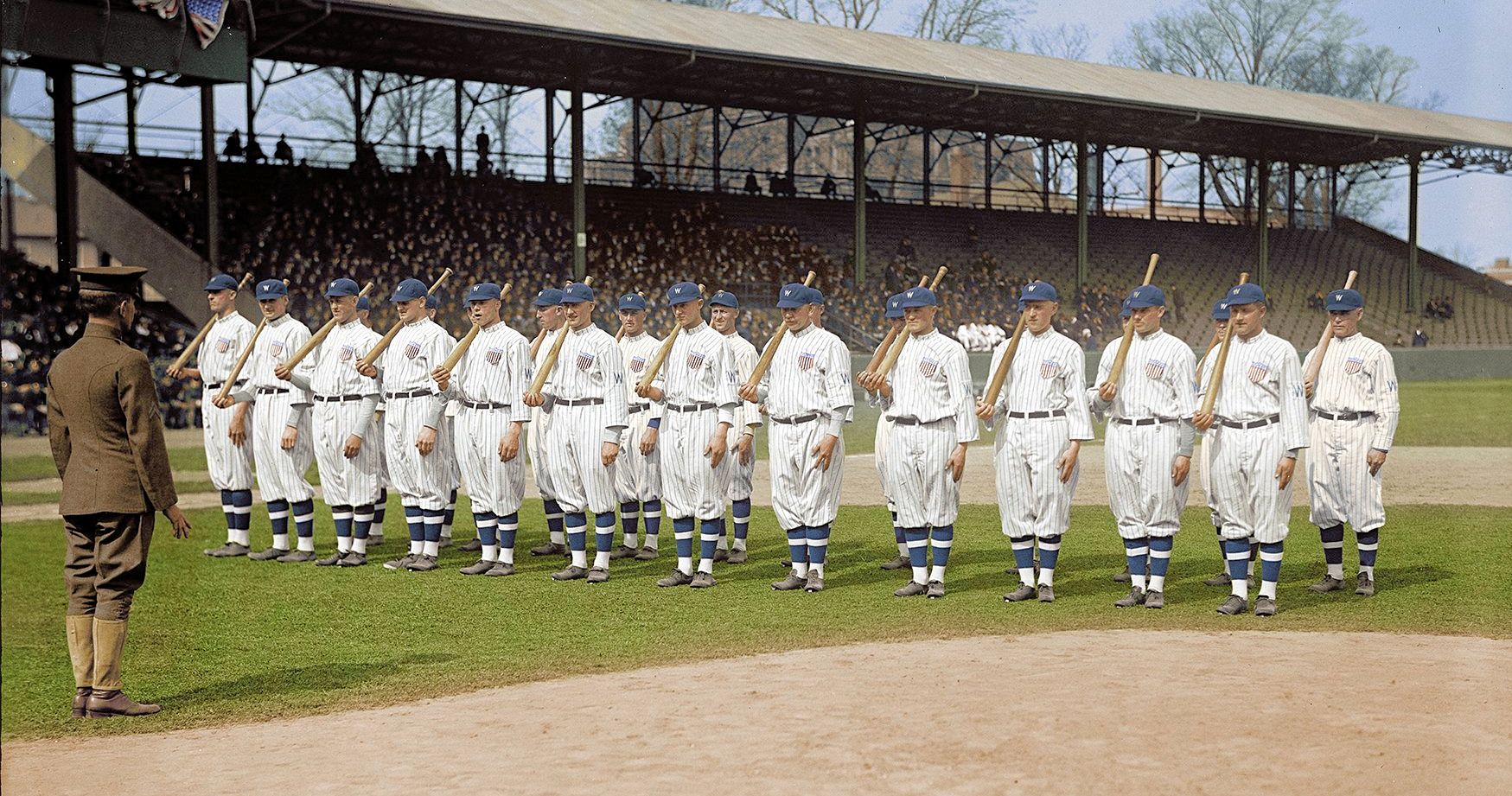|
1918 BOSTON RED SOX
With the United States now involved in the "Great War", most minor leagues closed up shop, but the majors went forward with their full schedule. Only a handful of players had been drafted into the military while even fewer enlisted. Those who continued to play took part in token military “drills” to show their support for the boys overseas. Owners donated fair amounts of cash to the war effort, and rounded up baseball gear for the soldiers, whenever they had time off from the brutal trench warfare.
The American public was not enamored. The majors were hounded to be more active with the war effort, to make truer sacrifices. The owners addressed some of the criticism. They offered that the game’s benefaction to the war effort went beyond bucks and bats. As the national pastime, baseball was keeping stateside spirits and patriotism high. In Boston, the Red Sox looked forward to reclaiming top league honors, having been beaten out by the Chicago White Sox the year before. But eleven of the Sox players were called up for active military duty, including Duffy Lewis, Herb Pennock, Ernie Shore and Jack Barry. To make up for the talent shortfall, President Harry Frazee, embarked on an aggressive player acquisition program. The Boston owner swung a pair of deals with Connie Mack’s Philadelphia Athletics to acquire firstbaseman Stuffy McInnis, outfielder Amos Strunk, pitcher Joe Bush, and catcher Wally Schang. In return, Frazee gave up very little. Apart from a declining Larry Gardner, several reserve players, and $60,000 in cash was included in the deal. He then traded for Cincinnati Reds veteran Dave Shean, a good infielder, and bought George Whiteman, a career minor leaguer. As for the managerial vacancy created by Jack Barry’s departure, he turned to Ed Barrow, a personal friend, who had served as president of the International League from 1911 to 1917. Babe Ruth was one of the league's best pitchers. When Babe hit his 10th home run of the year, he became the only player to hit at least 10 homers and win at least 10 games as a pitcher in the same season. From mid-July to early September, Babe pitched every fourth day, and played either left field, center field, or first base on the other days. Ruth’s double duty was not unique during the "Deadball Era", but his level of success was (and still emains) unprecedented. In one 10-game stretch at Fenway, Babe hit .469 (15-for-32) and slugged .969 with four singles, six doubles, and five triples. He was remarkably adept at first base, which was his favorite position. On the mound, he was 13-7 with a 2.22 ERA. Down the pennant stretch run in the month of August, he pitched eight times and won six of those games. Five of the six wins were games where he only allowed just one run. He allowed more than two runs only once in his last ten starts. The "Colossus", as Babe was known in Boston, maintained his status as one of baseball's top pitchers, while simultaneously becoming the game’s greatest hitter. But Carl Mays was the ace of the Sox staff, winning 21 games with a 2.21 ERA. He tied Walter Johnson for the league lead with eight shutouts and tied Scott Perry for the league lead with 30 complete games. He finished fifth in strikeouts and fifth in fewest hits allowed per nine innings. He also hit 11 batters, the second-highest total in the league. Joe Bush managed a 15-15 won-loss record, but with a career-best 2.11 ERA, a career-high 26 complete games, including seven shutouts and a team-high 125 strikeouts. Before the season, Dutch Leonard had considered doing something many of his Red Sox teammates had done, skipping out off baseball and joining a naval yard, which had very competitive baseball teams. And because employment at the naval yards, was considered war work, it could help keep a player out of the army draft with an exemption. As the season went on, Leonard reconsidered. He was Class 4 in the draft, because he had been married that fall and because he was a farmer. But as the draft exemption rules changed, Leonard was a good candidate to be bumped up, because draft boards overlooked the marriage exemption in cases where there was enough money for the wife to live without the husband (like Dutch) Plus, marriages that happened after the draft was instituted (like Dutch’s) were being discounted. Also farmers who were not actually doing the farming (like Dutch) were losing their exemptions. So, on June 22nd, Dutch Leonard left the Sox and signed with the Fore River shipyard in Quincy, Mass. It was good timing. Two days later, he was moved up to Class 1A. He did not play for the Red Sox again in 1918, finishing with an 8-6 record and a 2.72 ERA. Sam Jones delivered 16 victories against only five losses with a 2.25 ERA. When Ernie Shore left for the Navy, Dutch Leonard took a shipyard job, and Babe Ruth cut back a bit on pitching, Joe Bush and Jones got the opportunity to pitch more. Jones had a terrific year and led the league in winning percentage. Harry Hooper posted a .289 average and a .405 slugging percentage (second on the team to Ruth in both categories). During the World Series Hooper demonstrated his clear thinking and effective leadership, representing his fellow players’ concerns in a manner that preserved the integrity of baseball. Due to wartime travel restrictions, attendance and gate receipts during the regular season and World Series fell well below pre-war levels. However, at this time the players’ postseason bonuses came from gate receipts and the owners would not guarantee a minimum payment. The two teams, traveling on the same train, appointed four representatives, including Hooper, to speak to the governing National Commission and press their case. With the Sox leading three games to one, the players delayed the start of the fifth game by more than one hour in an attempt to secure concessions from the Commission. Although Hooper negotiated an end to the strike, and secured a verbal promise from Ban Johnson of no reprisals, he forever regretted not securing the guarantee in writing. After the Sox won the Series 4-2, its last for 86 years, the players received the smallest financial awards in World Series history. In his first year with the Sox, Stuffy McInnis batted .272 with only 10 strikeouts. In the World Series McInnis batted .250, well above the team’s lowly .186 average. He also fielded his position flawlessly.
The Red Sox bolted out of the blocks, going on a franchise best 11-2 record in April, and easily securing first place. Coming off back-to-back twenty win seasons, Babe Ruth mesmerized Philadelphia on April 15th with a 7-1 gem at Fenway Park, to start his year. A base hit with one out in the eighth, which Dave Shean valiantly attempted to get in front of, spoiled the night for Carl Mays on April 16th. It was the one and only hit he allowed against the Athletics. However, to take the sting away, the Sox broke a 0-0 tie in the bottom of the ninth inning to win the game for him. It was Everett Scott driving in Stuffy McInnis, who had doubled to right, with the winning run to give Mays a 1-0 win. In the final game of the series, pinch hitter Wally Schang, with the Red Sox one run behind, the bases loaded and no one out in the last inning, drove in the winning run that gave the "Speed Boys" a walk-off 5 to 4 victory and a sweep of the series with Philly. The New York Yankees and their new manager, Miller Huggins, lost two games to the Red Sox in a Patriots Day doubleheader at Fenway Park on April 19th. Joe Bush made his Red Sox debut in the first game and beat Allen Russell in a 2 to 1 duel. The afternoon game was all Red Sox in a 9 to 5 win. A sensational catch by Amos Strunk saved the game for Bush in the morning and it was lucky for Babe Ruth that the Yankees defense sprung a leak in the afternoon, because the Yankees hit him hard with 13 base hits. The Red Sox continued winning the next day, defeating the Yankees by a score of 4 to 3. Dick Hoblitzell squeezed in Harry Hooper with the winning run in the eighth inning. The Yank's Hank Thormahlen's had a no hitter spoiled by a ninth inning walk-off victory by the Red Sox on April 23rd, in a 1 to 0 thriller. It was Amos Strunk who slapped a single to spoil it for Thormahlen with one out in the ninth inning. At the time it was a 0-0 pitching duel between him and Bush.
In Philadelphia on April 25th, the Athletics fell to the Red Sox and Carl Mays by a 6 to 0 score. Mays had Connie Mack's men eating out of his hand. It was not until the eighth inning, when they got three hits, two of them being of the scratch variety, when the home team was able to score. Stuffy McInnis and Amos Strunk beat their old buddys from Philly in the next game, when they inserted themselves effectively into this game. The score was 2 to 1 in favor of the Red Sox. It was those former A's who were, once again, largely responsible for defeating their old teammates at Shibe Park, by a 4 to 1 score, and making three in a row for the Red Sox. In the final game with the Athletics on April 27th, McInnis knocked in two of the four runs, while the other two were the responsibility of Strunk and Wally Schang. But it was Joe Bush who kept his former team at bay by pitching a good ball game and picking up his third win. At Fenway on April 30th, the Sox beat the Nats 8 to 1 in their first meeting of the year. Babe pitched and up until the sixth inning, allowed only one hit.
The Sox continuously hit the ball on the button in the final series game on May 2nd with Washington, and walked away with an 8 to 1 laugher. The Sox jumped out to a lead in the first inning, with Harry Hooper slamming a double to left center. A single by Dave Shean, put Hooper on third, and Otis Strunk's double scored him. Wally Schang next singled to center, scoring both Shean and Strunk. The Sox got two more in the third and three in the sixth for Dutch Leonard, stretching their lead in the American League over Cleveland to 2 1/2 games. Just a month into the 1918 season, all of baseball found a critic they couldn’t ignore. He was Provost Marshall General Enoch Crowder, the director of the military draft. He decreed that by July 1st, all draft-eligible men, employed in “non-essential” occupations, must apply for work directly related to the war, or gamble being called into military service. Despite pleas for leniency from baseball’s owners, Secretary of War Newton D. Baker agreed with Crowder that life, as a ballplayer, was non-essential. So it was enlist to help stateside, or risk going to the front lines in Europe. Feeling that he had the skills to play every day, Babe Ruth badgered manager Ed Barrow to put him in games as an outfielder. Since it was a make-shift war season, Barrow inserted the left-handed hitting Ruth in the lineup against right-handers at first. The gamble paid off. Babe would go on to hit .300, with 66 RBIs in 317 at bats, while tying for the league lead in home runs with eleven. Ruth was a one-man wrecking crew. His home runs came in bunches and he hit them further than anyone had ever seen. In his first three full years at Boston, Ruth averaged a home run every 39 at-bats, while it took 457 for his teammates to eke just one out. On May 4th at the Polo Grounds, Babe hit a ball into the grandstand beating the Yankees, 5 to 4. Two days later, on May 6th, he again hit one into the upper deck at the Polo Grounds. And the next day in Washington, he hit one over the right field wall. On May 9th, in Washington, Ruth mgot five hits in as many times up, including a triple and three doubles. It was one hit more than was made by his teammates, but the Nationals beat the big left-hander out, in a heartbreaking 10 inning game, 4 to 3. On May 10th, a 4 to 1 victory was the result of the first engagement of the season with the St. Louis Browns. Babe, whose wonderful exhibition of hitting and all round skill, was the redeeming feature of an otherwise disastrous road trip, was in left field. The next day, Babe stung the ball on the nose for three base hits, and played a great game at first base. On May 15th, back at Fenway Park, a mighty ninth inning finish was made against the Tigers. The final count was 5 to 4 with the Sox scoring two runs in the last inning. The wallop that won the prize being knocked in by Harry Hooper. The next day, Carl Mays did the pitching for the Sox, and it was a good day, as he held the Tigers to four scattered hits, with Ty Cobb getting two of them. The final score went to the Red Sox, 7-2. It was a wild affair from the outset on May 17th, with the Sox beating the Tigers, 10 to 8. Dutch Leonard helped win his own game. He got three singles and drove in three runs. Ruth, Amos Strunk, and several others prevented the Tigers from winning any games at Fenway Park, with the Sox winning their fourth consecutive game from the Tigers, 3 to 1, on May 18th. Placing hits all over the field, the Sox marched onward on May 20th, winning their first engagement of the season from the Indians, by a score of 11 to 1 at Fenway Park, their sixth consecutive triumph. Every Sox player except one, had a base hit. Using the bat, as well as his strong right arm effectively, Joe Bush played a prominent part in the 5 to 1 victory that the Red Sox scored over the Chicago White Sox at Fenway on May 24th. His single to center the ninth, drove over the winning run. He drove in three runs, slammed out two hits, and except for a couple of fielding miscues, held the White Sox runless until the eighth inning. In the next game with the White Sox, Chicago's Lefty Williams, in the 10th inning, found it necessary to pass Harry Hooper purposely. The following batter, Dave Shean hit a solid liner to deep left field, sending Wally Schang scooting over the plate with the winning walkoff run, 3 to 2. In the final game of the series, on May 28th, it was another Bush day, and for the second time within four days, timely batting by the "Bullet" proved the undoing of the White Sox. The score was 1 to 0, with Joe driving in the lone score in the fifth inning, while he held the White Sox to one stingy base hit, a single to short right field in the first inning. While it was cold at Fenway, on May 29th, as the Sox succeeded in making it a frightfully torrid day for the Washington Nationals, taking both ends of a doubleheader by scores of 4 to 2 and 3 to 0. The feature of the night game was Sam Jones' shutout victory over Walter Johnson, holding the Nats to five scattered hits. The Sox ended the month dividing the games played in another doubleheader. The Sox won the morning contest by a score of 9 to 1 and Washington, taking the afternoon game 4 to 0. The Sox (25-14) finished the month in first place, two games ahead of the Yankees.
The Sox started June in Detroit and Babe went on a tear, hitting eight home runs. On June 2nd he hit one into the right field bleachers at Navin Field. Then he did it again twice over the next two days.
After losing the first two games of the series, on June 3rd, Dutch Leonard pitched a no-hitter, the second of his major league career, shutting out the Tigers 5 to 0. Only 28 Tigers faced Dutch and all but Bobby Veach, failed to reach first base. This was in the first inning, when he was passed him after two men were out and of course Veach got no further. And the first time, Babe came to bat, he hit another home run. The Sox took the final game 7 to 6, putting on a rally in the ninth inning and making the series an even split. The Sox scored three runs in their half of the sixth inning. Harry Hooper opened the inning by bounding one by Donie Bush that was too hot to handle, and it went for a single. He lost no time in stealing second, and scored when Dave Shean singled past first base. Then Babe poked his third home run of the series in the regular place, the right field bleachers, scoring Shean ahead of him. On June 5th the Sox traveled to Cleveland and Babe's fourth home run in four days, went into the right field screen at Dunn Field. In the next game, with the game scoreless, Hooper started the tenth inning, with a pass. Dave Shean bunted to to the pitcher, Stan Coveleski, but his throw was wide, trying to get Hooper. Amos Strunk then bunted toward third and again Coveleski pounced upon it, and again he tried to head off Hooper. This time his throw to third base was not only wide but too late, and the Sox won 1 to 0.
Dutch Leonard won his own game for the Sox, blanking the Indians 2 to 0, on June 9th. He was a deciding factor in both of the runs scored by his team. In the fifth inning his single to left center moved Everett Scott to third, and in a position to score on Hooper's long sacrifice fly to right. With two outs in the seventh, Wally Schang singled and went to third on Leonard's second safe base hit. Hooper's single scored Schang. Leonard was just as effective with his pitching as with his bat. Holding the Indians at his mercy in the first three innings, he kept them away from the plate in the next six innings, despite the fact that Cleveland persistently got men as far as second and third. The Red Sox, like many other teams, lost valuable players during the season to the war effort. Team Captain, Dick Hoblitzell was declared eligible for the military draft and had passed an examination for the U.S. Army Dental Corps in March. He received his commission as a first lieutenant on June 6th and left the Red Sox three days later. He never played another game in the majors. On the field in Chicago, on June 10th, the Red Sox won their first game of the year at Comiskey Park, because Joe Bush held the White Sox to only a pair of safe hits. The final score was 1 to 0. After losing the next game, Carl Mays stood the White Sox on their heads on June 12th. Only three widely scattered hits were made off him, winning the game 7 to 0, in the third game of the series. In the final games of the series, the White Sox submitted to another whitewash, making only five hits off Dutch Leonard. The score was 6 to 0. It was the third time, the Sox blanked Chicago in four days. On June 15th, the Sox played at Sportsman's Park in St. Louis, and Babe Ruth hammered the Browns into submission. The slugger drove over five of the eight runs made by the Red Sox, in am 8 to 4 win. The Browns could only chase ain four runs on the eleven hits made off Sam Jones. Babe had four chances to drive in runs and made good on three occasions, with the climax coming in the seventh inning with the score tied. With two on base and two outs, all the Babe did was to lift one into the right field bleachers and trot around the bases behind his two teammates. In the final game of the road trip in St. Louis, on June 17th, the Sox received great pitching from Carl Mays. The end result was 8 to 0. Mays was in grand form, as he allowed only four hits and, with the exception of three of the hits, did not allow the ball out of the infield until the final play, when Ray Demmitt lined one out to Harry Hooper. When the Sox returned to Boston, on June 20th Leonard had his classification in the military draft changed. He therefore quit the team to take a job at the Fore River Shipyard in Quincy, Massachusetts. Baseball was given a reprieve of sorts. The “Work or Fight” deadline was delayed two months to September 1st and even then, the owners had to furiously lobby for a deadline extension for the World Series participants. The government reluctantly gave it to them. So while the season would be shortened by two weeks, it wouldn’t be killed in midstride. But with the vast number of players, an average of 15 per team, drafted or enlisted before that deadline, teams scrambled to replace veteran players with others of lesser quality and experience. Who left and who remained shaped up the balance of power in both pennant races. On June 21st, Carl Mays was on the very threshold of baseball immortality, but a dinky rap in front of the plate, in the fifth inning was all that kept him from becoming a member of the no-hit club. It was an easy chance that Wally Schang should have made, but he permitted Mays to make the play and the runner beat his peg to first, for the only hit by the Athletics at Fenway. The Red Sox won the ballgame, however, 13 to 0. Dave Shean had four hits, while Hooper and Ruth each had two, including a triple.
In New York, at the Polo Grounds on June 25th, Babe smashed another home run. It was his third one of the year there. In the next game, in the ninth inning, on June 26th, when Babe came to bat, he banged one toward his favorite spot in the right-field stands. It looked like a sure home run, but lost headway just as it reached the grandstand wall, and struck 6 inches below the top of the rail. The ball bounded away, but Babe got two bases on the clout. It was the first time that he failed to hit for a home run, in a game at the Polo Grounds, this season. On June 28th, Babe's home run, a terrific smash over the right field wall in the seventh inning, was the only dent, the Red Sox could make in Harry Harper's pitching performance at National Park in Washington. It was Ruth's 10th home run of the season. Babe's final home run of the year came two days later. On June 30th he hit the longest home run ever hit at the ballpark in Washington, up until that time. It gave the Sox a 3-1 victory over Walter Johnson. All of Babe Ruth's home runs were on the road.
But with Ruth’s success came problems. With every home run he hit, the Babe’s ego swelled. Never one to adhere to the rules, the thrill-seeking slugger now seemed worse, drinking, gambling and whoring most of his nights away. He made more money that anyone in baseball had ever made and it became inevitable that he would clash with his straight-laced manager. Things came to a head on July 2nd between Babe and Ed Barrow when Ruth threatened to quit the team and play semi-pro ball in Chester, PA. Owner Harry Frazee was not amused and threatened Ruth with court action since he owned Ruth’s contract. The Babe sheepishly rejoined the team on July 4th. After having led the American League for most of the season, the team had slipped behind the Cleveland Indians by one game in the AL standings. But with the chastened Babe Ruth back with the team, the Red Sox started winning again. The Sox proceeded to take four of five from the Indians at home. Babe's home run production stopped, but even though he kept the ball in the park, he was a one-man wrecking crew. On July 6th the Sox were two behind, with two on and none out, Babe hit a smash to the right-field corner for a triple and gave the Sox a 5 to 4 victory over the Tribe. Against the Indians on July 8th, Babe hit a ball in the 10th inning, 3/4 of the way up into the right field bleachers at Fenway Park for a walk-off Red Sox 1-0 victory. The blast into the bleachers was not considered a home run, because Amos Strunk was on first. By the rules at the time, Babe's smash into the bleachers was only a triple. If it hadn't ended the game, it would have been a home run in any other inning and ultimately the 715th of his career. Surprisingly, he never was credited for a home run at Fenway Park in 1918. Then it was Wally Mayer, a mere understudy, who carried all of the select stuff that every star needs, who provided the big climax that sent more than 4000 fans home to dinner happy from Fenway Park on July 9th. His walk-off liner to left, against the Indians, with two down in the 12th inning, supplied Joe Bush, with a 1 to 0 decision. Then on July 10th, Babe hit a triple to win the game, 2-0 against the same Indians. On July 11th the Chicago White Sox lost to the Red Sox, 4 to 0, and all Babe did was hit the ball to left field three times, each one for a double. The next day on July 12th, he had two triples and a double, in four times at bat, in a 6 to 3 victory over the White Sox, pushing the Red Sox American League lead over the Indians to 3 1/2 games. It was another day at the ballpark for Carl Mays when he hung a 3 to 1 defeat on Chicago at Fenway on July 15th. Outside of the seventh inning, when White Sox shoved over a lone run, the visitors could not do anything with Mays. In that inning, when another hit would have caused a bunch of damage, Mays just planted the lid on the trouble in a businesslike way. With George Whiteman at the plate and getting set to do combat in the final inning, former Sox catcher Les Nunamaker, presented the Sox, with the game, throwing past Fritz Maisel at third while trying to break up a double steal, and permitting Dave Shean too score the winning run, as the Sox defeated the Browns 2 to 1, at Fenway on July 16th.
The next day, everybody got a run for their money. Both sessions of a twin bill were won by the Sox, the first game by a 7 to 0 score, and the second by a 4 to 0 score. Joe Bush pitched in the opening game and was opposed by Rasty Wright, a slender right-hander recruited from Ohio State University. The Sox pounded Wright hard and allowed Bush to take it easy after the Sox got well out in front. Bush got three hits and drove in three of the Red Sox runs. In the second game, Browns pitcher Tom Rogers was an easy mark from the beginning. On July 19th, Mays earned his 16th win of the season, overpowering the Detroit Tigers 5 to 0 at Fenway. Mays had everything going for him, holding Detroit to three scattered hits and only two of them out of the infield. The Sox had stretched their lead in the American league to 5 1/2 games over the Indians. Off the field that day, in response to a directive by the Secretary of War, Newton Baker, that said all ballplayers of eligible draft age must "Work or Fight" in war related enterprises, most of the minor leagues ended their seasons. Major League teams scrambled to sign the players. Because of the shortage of players, the Red Sox were forced to play college and minor league players. Players with names like Jack Stansbury, George Cochran, Eusebio Gonzalez, and Red Bluhm appeared in 1918 and were never heard of again. Meanwhile, major league players, such as Babe Ruth, fielded offers to play for the company sponsored teams of war related industries. American League President Ban Johnson, National League President John Tenner, and the owners of the teams, had worked out a compromise with the War Department to shorten the season and end it at Labor Day, with the World Series held right after. On July 20th, before 13,500 fans, the largest crowd that has seen a game at Fenway Park this season, the Red Sox beat Ty Cobb and the Detroit Tigers, 5 to 1. But on that peaceful midsummer morning on Cape Cod, out of the haze a big German submarine probably 400 feet long, came to the surface. After an hour and a half of shelling, in which several hundreds of shells were fired, the sub exceeded in sending to the bottom of Nauset Harbor, a coal barge and a barge loaded with stone damaging, a fourth barge, and setting a tugboat on fire. On the barges were 12 men, four women and two boys, all of whom were rescued. The crew of the oceangoing tug comprised 16 men, all of whom got off safely in the boats. Baseball now seemed much less important since the war had come directly to America's shores. Playing the most games at third base was 25-year old Fred Thomas. Thomas had arguably the most interesting season of any member of the Red Sox. He left the team and was at his Wisconsin home for his pre-induction physical. He went to Great Lakes Naval Air Station as a sailor. The base was located in Chicago, and its commander, Captain William Moffett, was a baseball fan. Thomas later said the command was attractive to a large number of talented players. He would a member of two championship teams in 1918. His Great Lakes team took the Navy Championship. With a six game lead in the American League, the Red Sox realized that the pennant and World Series were now close at hand. They got down to business and beat White Sox with a seventh inning rally, by a score of 6 to 4 at Comiskey Park on July 27th. The credit for the victory lies in the prowess of Joe Bush, who not only hurled a steady game, but produced the staggering blow with his bat in the seventh inning. On July 29th, Babe Ruth took a turn on the pitcher's mound at Sportsman Park and hurled and batted the Sox to a 3 to 2 victory over the Browns. The Babe held St. Louis to four hits, three of them being bunched in the sixth inning. At bat, Ruth got only one hit in four times up, but this it was a triple to left-center. In the next game, five pitchers, eleven runs, fourteen base hits and great support in the field, gave the Sox and 11 to 4 victory over the Browns. The Sox made it three straight wins over the Browns, by taking the third game of the series. The game was interesting until the final inning, when the Sox chased over four runs and won the game 8 to 4.
St. Louis catcher, Hank Severeid's wild throw of Wally Mayer's intended sacrifice bunt, was the decisive play in the fourth and final game of the series with the Browns on August 1st. It permitted the winning run to score in the first half of the eighth inning, giving the Red Sox 2 to 1 victory, with Babe on the mound. With a 5 1/2 game lead, the Sox went to Cleveland to face-off with the second place Indians. After losing the first two games, the Sox on August 4th sent Babe to the mound in the first game of a doubleheader. It was a must win game and Babe not only dove in the Sox first run, but he also held the Tribe to just four hits. The Sox lost the second game however and left Cleveland with the Indians two games closer to them. In Detroit on August 6th, Carl Mays was not puzzling to the Tigers at all. Then came a change that resulted in the 7 to 5 victory for the Sox in 10 innings. The Tigers beat the Sox the next day, but the Sox wound up the Detroit series with a 4 to 1 victory on August 8th, behind Babe Ruth's pitching. He had plenty of stuff in reserve on the few occasions which Tiger hitters threatened to start trouble. Back at Fenway, the Yankees started the Fenway homestand by sweeping the Sox. The the Chicago White Sox came to town. On August 14th, the Red Sox trimmed the White Sox' Reb Russell for the first time in four meetings, by a score of 5 to 3. After losing the next game, the Red Sox hung a 2-0 win in the final game of the series with Chicago on August 16th. Joe Bush held them to only five hits. Another crucial showdown with the Indians started on August 17th. With the lead only two games, Babe Ruth pitched the Sox to a 2 to 0 shutout victory. Sam Jones then shutout the Indians 6 to 0, on August 19th, holding his former teammates to just two hits. The Sox had now won 10 out of 19 games from Cleveland. The Indians, before leaving town, kicked the stuffing out of the Red Sox by a score of 8-4, but ended up losing a game in the standings. On August 21st, the St. Louis Browns opened their series at Fenway by having the Sox beat them 4 to 1, and in the process Carl Mays posted his 19th victory of the season. Two days later, on August 23rd, Sam Jones managed to squeeze through a 6 to 5 win over the Browns. There were two out in the ninth and the Sox had two men on. The Browns' catcher, Hank Severeid threw high to Fritz Maisel at third, trying to break up a double steal by Ruth and Amos Strunk, allowing Strunk to skip in with the winning run. The Sox were held to just four hits, on August 24th, two of which were infield hits, yet the Sox won the ballgame 3 to 1. Babe pitched and it is fair to say he did not pitch well, but when he stole home in the second inning, it appeared that he suffered a wrenched knee. However, he finished the game and held the Browns to five hits, only two of them getting beyond the infield. With only ten games left in the season, the Sox lead over Cleveland was four games. The Tigers came into Fenway and took the first two games played. But in the third game, on August 28th, Harry Hooper went on a batting spree and Sam Jones, shut out Detroit, winning 3 to 0 in the final game of the season between these two teams. The Tigers were again without Ty Cobb, who reported for military duty and was now a captain in the Chemical Warfare Service. Harry Hooper had a pair of doubles and a triple off Hooks Dauss.
On August 30th the Sox and the Athletics played a Fenway doubleheader. Carl Mays had his submarine ball dominate the Athletics starting both games. The first game was a romp, the Sox registering a 12 to 0 victory. It was plain to see before the first game got going, that the Macks would never catch the boys from Fenway and Mays just stuck the ball over the plate, taking it easy, and grooming himself for the encore in the afternoon. Mays (21-13) had a fine day, winning his 20th and 21st games, pitching and hitting well, fielding his position with his normal class. A 6 to 1 victory over the Athletics in the first half of a doubleheader, on August 31st, brought the American League championship back to Boston. Babe Ruth pitched in the opener for the Red Sox and held Philly three blows. After resting for the first few innings of the second game he went in to play centerfield.
Sam Jones had the best winning percentage on the team, going 16-5 with a 2.25 ERA, while Ruth finished 13-7 with a 2.22 ERA. Joe Bush won fifteen games and posted a 2.11 ERA with seven shutouts. Wally Schang proved a highly dependable catcher, and Stuffy McInnis finished second to Ruth in team RBIs with fifty six. In the National League, the Cubs, led by Jim “Hippo” Vaughn and George “Lefty” Tyler won the pennant, in spite of a late season challenge by the New York Giants. The earliest World Series on record kicked off on September 5th at Weeghman Park in Chicago. The Red Sox, behind Babe secured a 1-0 victory in Game #1. During the seventh inning break, on a whim, a patriotic move was started by a brass band that struck up “The Star Spangled Banner” to the express delight of the fans and players. And thus, a time-honored tradition was born at baseball games forever after. Joe Bush was given the starting assignment for Game #2 against “Lefty” Tyler. The two dueled each other brilliantly with Tyler coming out on the end of a 3-1 victory for the Cubs. In Game #3, working on short rest, “Hippo” Vaughn pitched well enough to win, but was let down by an anemic offense in a 2-1 loss to Mays.
Having taken two out of three in Chicago, the Red Sox were confident when they came to Boston for Game #4. The excitement stopped when Babe injured his hand on the train rough-housing with Walt Kinney. In spite of his injury Ruth took the mound and battled “Lefty” Tyler. Ruth pitched seven shutout innings, in spite of not being able to grip the ball tight enough to pitch an effective curve. The Cubs wasted another fine pitching performance by Tyler to lose the fourth game by a 3-2 score. In a move precipitated by greed, the league decided to announce that they would have to give the players a smaller share of the money generated by the World Series. Both the Red Sox and Cubs players decided to stage a boycott against the owners before Game #5. The players finally agreed to play the game for the sake of the fans. When the players came out on the field an hour late, they were booed by the crowd. Only when the actions of the mayor, John “Honey Fitz” Fitgerald, who came out on the field with a megaphone, telling the crowd that it was the players who agreed to compete for the fans, did the boos turn to cheers. The game progressed and it was “Hippo” Vaughn, who finally prevailed shutting out the Red Sox and winning the game 3-0, on five hits. For Game #6, the crowd was small in a response to the antics of the day before. Despite the lack of hometown support, the Red Sox took the game by a 2-1 score, thus earning the World Champion title for the fourth time in seven years. It would be the last time the Red Sox would win the World Series for 86 years. After Babe pocketed his World Series share, he spent the evening acting as the official starter for bike and motorcycle races at the Revere Beach Race Track. Then Babe refereed a local boxing tournament and attended the George Cheney – Lew Tendler fight in Philadelphia on September 18th. The Babe mulled over at least seven shipyard offers and a motion picture producer contacted him about a possible film with him offering baseball tips. He turned down an offer to play ball in California's War Service League, but did grab his bat and glove for a few games in New England. On September 15th he pitched a 1 to 0 shutout for the Polish Club before a huge crowd in Hartford, Connecticut. Reports of how much Ruth was paid varied from $350-$1300.
A week later, the Babe relieved Walter Johnson in an exhibition game against the New Haven Colonials. Ruth wasn't the only Red Sox player playing in exhibition games. Joe Bush, Wally Schang, Wally Mayer, Amos Strunk, Sam Jones, Everett Scott, Sam Agnew and Hack Miller formed a barnstorming club with several other major league players. The team was advertised as the "Red Sox". After a loss to the Baltimore Dry-docks and Shipbuilding Company, Harry Frazee caught wind of the operation and demanded that they stop using the name Red Sox. On September 25th, Babe accepted a job with the Bethlehem Steel Company, and he and his wife relocated to Lebanon, Pennsylvania. The "Red Sox" now billing themselves as the "All-Stars", played against the Babe and his Lebanon mates in a barnstorming game. Babe played first base, batted fourth and struck out twice against Joe Bush, who three-hit the Lebanon team, and won 4 to 2. The sudden influx of it players into the shipyard industry saw many hired as ringers, just to play on company teams and were assigned nominal duties, such as carrying blueprints or paint cans from one spot to another. More than 2000 workers at the Camps Shipyard near Philadelphia went on strike, protesting that ballplayers and actors had been given supervisory jobs and never really worked. Influenza had first appeared in the spring, but in September it return to the East Coast with a vengeance. Boston was a busy port for returning servicemen, and American soldiers had apparently brought back with them a stronger strain of the disease. With rallies and parades going on to support the war, the flu rapidly spread among the crowds of people in east coast cities. It spread from Boston to New York and Philadelphia, then across the country. More than 195,000 Americans died in October of 1918 alone. The first death from influenza was reported in Quincy Mass. The victim was 15-year-old Daniel McDougall. The boy was taken sick and died two days later. McDougall worked as a South Braintree factory worker and was quite strong and fit until he became ill. Among those who died was American League umpire, Francis "Silk" O'Loughlin, who had been in the game for more 24 years. Carl Mays headed home, got married, and after his honeymoon, traveled to St. Louis with 17 other men from Mansfield, Missouri to join the service on November 6th, only five days before the armistice was signed. Ten of those men never made it back alive from Europe. Others never even got to put on a uniform. They had arrived, just as the flu epidemic was hitting its peak there. Mays stayed healthy, but some of the men he was with were quarantined immediately and Mays never saw them again. He called this the saddest and most ill-fated trip of his life Babe Ruth contracted influenza twice. In mid-September, he got sick while visiting his relatives in Baltimore. Roughly a month later a story from Lebanon, Pennsylvania stated that Ruth had contacted the flu and was recuperating. Neither instance was serious to him, and apparently no other Red Sox players were ever affected. On November 11th, an armistice was signed with Germany, ending World War I.
|

